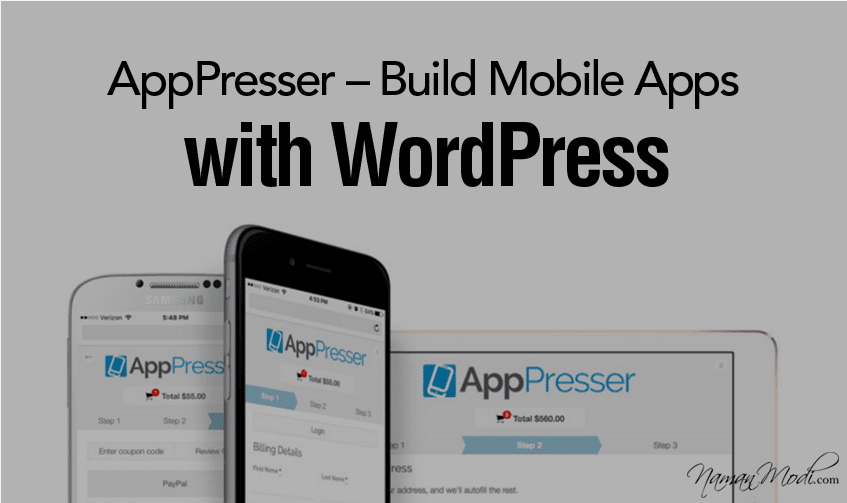Running a WordPress website has its challenges, one of them being how to build a WordPress for Android mobile app for your subscribers and/or visitors. There are several ways to create an app from a website without building an app from scratch. WordPress Mobile app allows you to send notifications, alerting your audience of new content and they can easily share your stories right from their phone or tablet. There are numerous tools used to build mobile apps, but this particular post focuses on AppPresser mobile app builder. AppPresser blends both ease and technical control to give you a superb end user experience. It uses plugins to integrate with Adobe’s PhoneGap platform. Its custom extensions and additional development, allows you to integrate with any device feature supported by PhoneGap such as contacts, geolocation, or camera.
AppPresser WordPress mobile app builder allows you to create a WordPress for Android and iOS mobile apps from your existing WordPress site and distribute it through the iTunes Store and Google Play. The mobile app builder allows you to integrate push notifications, create an e-commerce store using WooCommerce, a social networking app using BuddyPress, or you can do custom development to build any set of features supported by PhoneGap’s API. Its installation will not affect a look of your desktop or mobile site, it’s only visible inside your mobile app. Your normal website theme and functionality will not be affected at all. Meaning, if you visit your website through the normal internet browser on your device, you will not see any indication of AppPresser’s existence. This allows you to convert WordPress to an app.
You, however, need to seek host services from a fast hosting solution for your WordPress site if you want to maximize on AppPresser’s potential. For managed hosting, the mobile app builder recommends WPEngine. Your users must have an active internet connection to access AppPresser apps since they don’t work offline. AppPresser app creator offers additional extensions to enhance the presentation and function of your application; they are all available in the agency bundle. These include:
- AppPush – for integrating with push notifications (available with the standard bundle)
- AppBuddy – for integrating with BuddyPress
- AppCamera – for building photo sharing applications
- App-Geolocation – for integrating with Geolocation
- AppSwiper – a nice touch-enabled slider widget for your app home page
- AppWoo – for integration with WooCommerce
Table of Contents
Building your app
A basic AppPresser WordPress app is available for $199, but if you want camera integration or e-commerce, it’ll cost you $499. If you’re interested in comparing and estimating the cost of building an app from scratch without AppPresser, it provides links to a couple of great web resources. Your apps can either be listed in the iTunes Store and Google Play yourself or you can pay AppPresser to do it for you for $499. To purchase an AppPresser bundle, It’s recommended that you register for and review the free AppPresser Developer Handbook. Once you’ve purchased either the standard or agency bundle, you can get started building your app.
View Pricing
Getting started
You first have to install the AppPresser Plugin. This is done on the WordPress dashboard directory. The plugin integrates your WordPress site to the app features and extensions that AppPresser provides via PhoneGap. Secondly, you have to Install the AppPresser Theme and AppSwiper Plugin. This theme is recommended because it doesn’t affect your existing desktop or mobile HTML site. Its theme is designed to be used by touch-based devices, whereas typical WordPress themes are not. After you’ve installed the plugins and themes the next step is to log in to your AppPresser.com account. Click on My Account, then View Details and Downloads to get your license keys and theme download. You can also get other plugin downloads on this page. From your WordPress Dashboard, add the theme zip file that you downloaded and don’t activate it yet. You can then upload the Swiper plugin you downloaded and activate it. Turn on “Load AppPresser for Administrators Only”. This will let you preview your app as the admin. It will not affect your site’s normal operation. To see your normal website, browse your site in incognito mode. Enter your license key as well and save the settings. Although it will function, it will not give a great experience out of the box. That is why you need to build a distinct custom home page for my app.
See More: Mobile Marketing Tips that drive Leads and Sales
Build Your App Home Page
The WordPress app creator recommends that you build a distinct home page for your app. This will only be seen when people are using the app. It doesn’t affect the desktop or mobile HTML website. This can also be created from the WordPress dashboard and helps to turn off discussions on this page since comments are not optimized for touch-based apps. The AppSwiper plugin helps to create new custom post types called Sliders.
Listing Your Apps
You need to purchase an Apple iOS Developer Membership for $99 and Google Play license for $25 to list and sell your apps in iTunes Stores and Google Play. AppPresser will build and list your app in the stores for $499, or you can use their step by step guide to do it yourself.
Marketing Your App
Once your app is available in the store, the next step is to put up campaigns to promote your apps. You need to spread word about your new app. The social media platforms are a great way to share this information. Tell your readers through all the typical channels, email, Facebook, Twitter, etc. But, you’ll probably also want them to see a smart banner at the top of your site when they browse your mobile website.
Conclusion
Developing mobile apps is not an easy task. You need technical skills to create apps that are highly responsive to mobile devices which offer great user experience. AppPresser WordPress mobile app builder is a great mobile app builder capable of delivering functional apps that integrate with numerous platforms and support for smart devices.
Here are few more topics that you shouldn’t miss:
Capitalizing on Mobile Marketing as a Small Business
Making Money with Mobile Marketing
Tips for Optimizing Mobile App for Google Play Store
Like this post? Don’t forget to share






